Erin, Triton and The Great Industrial Exhibition
Visitors to LASSCO Three Pigeons near Oxford will today be greeted by a fabulous lifesize figure of a harpist. She is “Erin”, a personification of “Ireland”. She was created by sculptor John Bell in 1852.
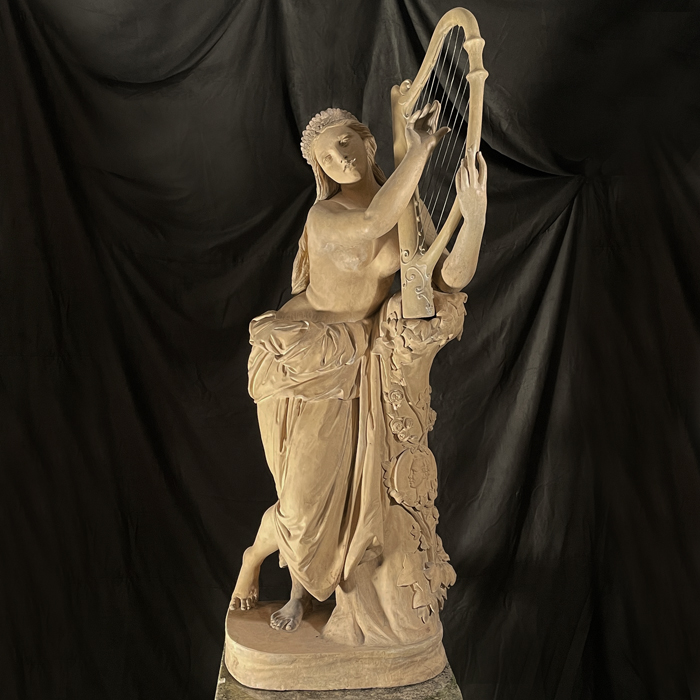
Photo (c) A. Reeve
Bell was, for a few years in the 1850’s, working at J.M.Blashfield’s workshops on The Isle of Dogs east of The City of London. In order his sculptures could be rendered as stoneware casts, moulds were created, casts were made, and the resultant clay figures were assembled, chased, finished and fired in Blashfield’s kilns. Blashfield’s intention was to take on the mantel of Eleanor Coade’s business (later known as “Croggon’s” up-river at Lambeth – defunct by 1840). He was competing with other workshops resurgent in this competitive but growing market for sculptural, and architectural, stoneware ornament – none moreso than with Mark Blanchard whose works were on Blackfriar’s Road, Southwark.
The work of both John Bell (1811-95) and Mark Blanchard (1816-92) had been prominent at The Great Exhibition of 1851. Blashfield (1811-82), an irrepressible entrepreneur with a sizeable yard already attracting prestigious clients, was galvanised by the possibilities of what he saw there and soon engaged with Bell in order to have one of the best sculptors of the day create statues he could reproduce.
Following the success of The Great Exhibition in Hyde Park, a similar show was organised to promote Industry and the Arts in Ireland: “The Great Industrial Exhibition” in Dublin of 1853 one of many great national exhibitions that were set on emulating the Hyde Park show across Europe and America in ensuing decades. Blashfield, who was very critical of the standard of his competitors’ “terra cotta” wares he had seen at the Crystal Palace, seized the opportunity to get his products showcased in the Dublin exhibition.
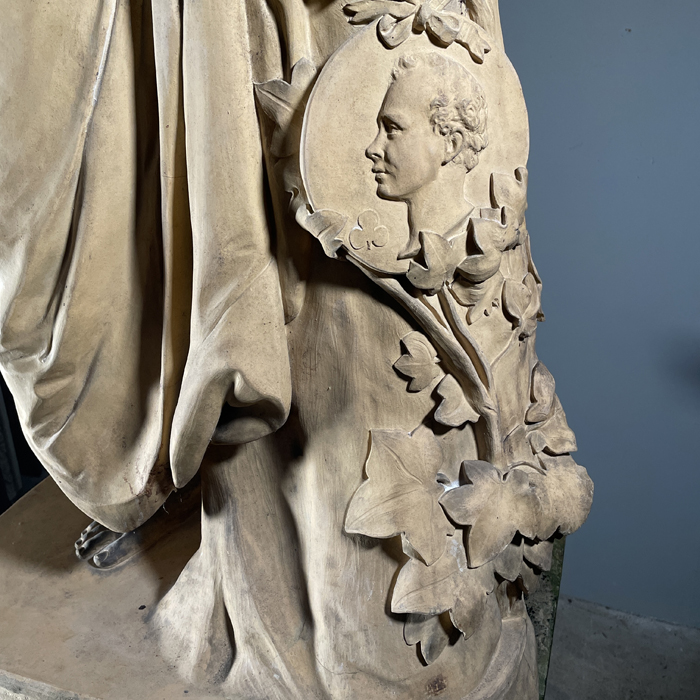
Look closely at the tree-stump against which Erin is leaning and there is a portrait medallion – beautifully modelled in relief. The young man depicted, together with a shamrock motif, is the Irish poet and bard Thomas Moore (b. 1779) who had died earlier that year (1852). Thomas Moore can be considered the national bard of Ireland much as Robert Burns is of Scotland. The Great Famine had ground-on since 1845, so for the Irish, Moore’s death marked a time of reflection and mourning; he was a rallying figure. Large bronze memorial statues celebrating the lyrical poet were to be built in Dublin, in Australia, in Central Park New York and elsewhere. So Erin, the name referencing Moore’s poem “Erin, Oh Erin”, and personifying Ireland, with her harp and shamrock hairband, was an intentional and direct appeal to Irish tastes.
Unfortunately, the figure could not be completed in time and was not shipped.
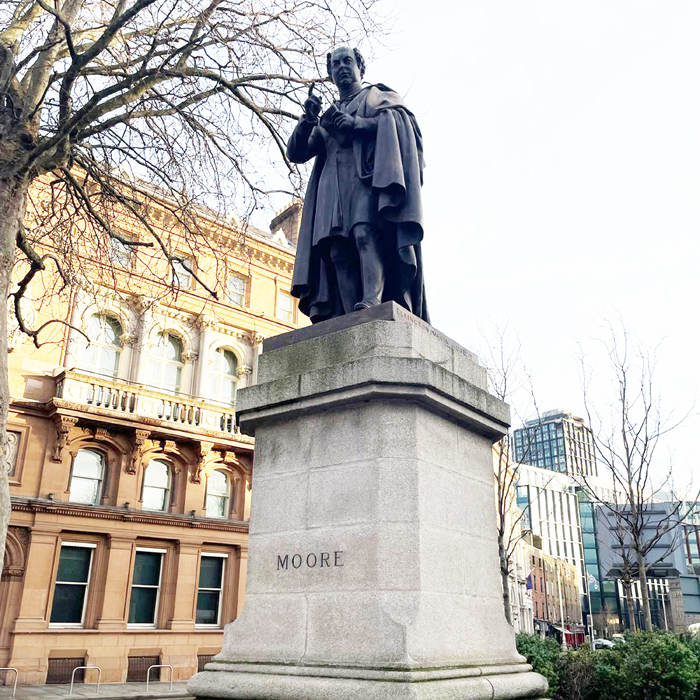
A drawing of Erin was later to appear on the front cover of Blashfield’s 1860 “Catalogue of Seven Hundred Articles”; as Blashfield had always intended, with the moulds made, the statue could be cast again – and it could be had for £5-5s-0d.
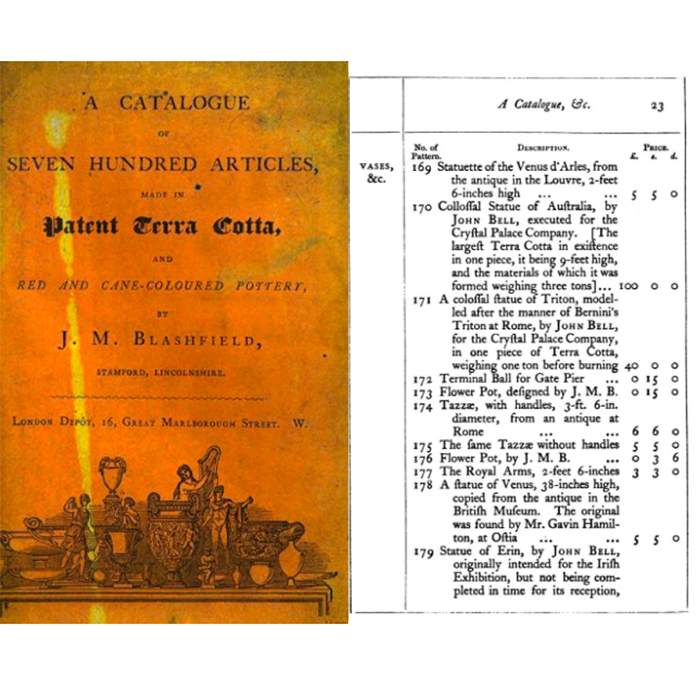
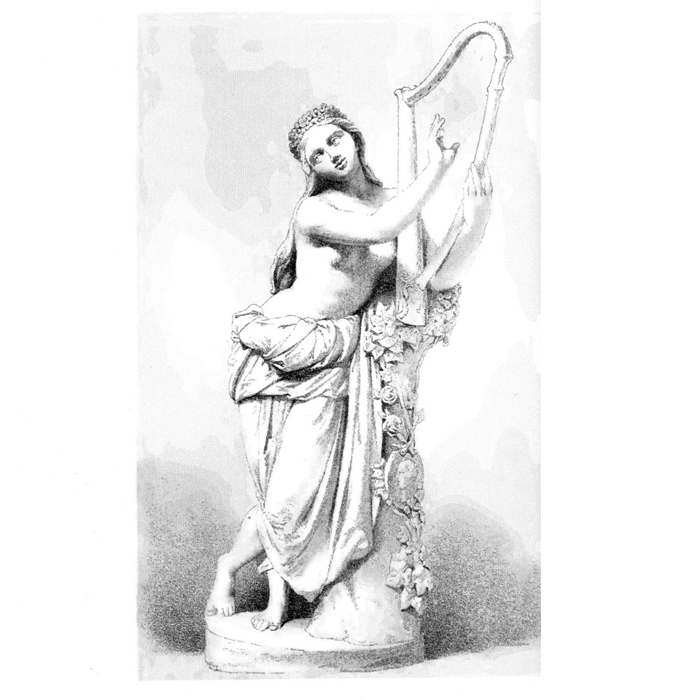
Blashfield and Bell’s collaboration continued apace and on a bigger scale. They worked on monumental sculptures to embellish Paxton’s Crystal Palace for when it was dismantled in Hyde Park and moved to its permanent location on Sydenham Hill by 1854. “Una and the Lion” and “Australia” were two commissions secured. The latter at 3metres high was fired in one piece – she was the biggest piece Blashfield ever attempted to get in his kiln. Both were destroyed in the fire that engulfed The Crystal Palace in 1936.
“Triton” is another sculpture that was the product of this partnership; it will be familiar to many – particularly for those who know Oxford (only a few miles from LASSCO Three Pigeons). He is the stoneware merman figure, with coiled tentacle legs, that forms the centre fountain outside the Radcliffe Infirmary – an Oxford landmark. Bell created the figure for Blashfield to produce in 1857. Based on Bernini’s fountain in Rome (there with a conch shell), Bell’s Triton is perched atop an outcrop of coral. He strains to hold aloft a large scallop, into which he blows, forcing jets of water into the air.
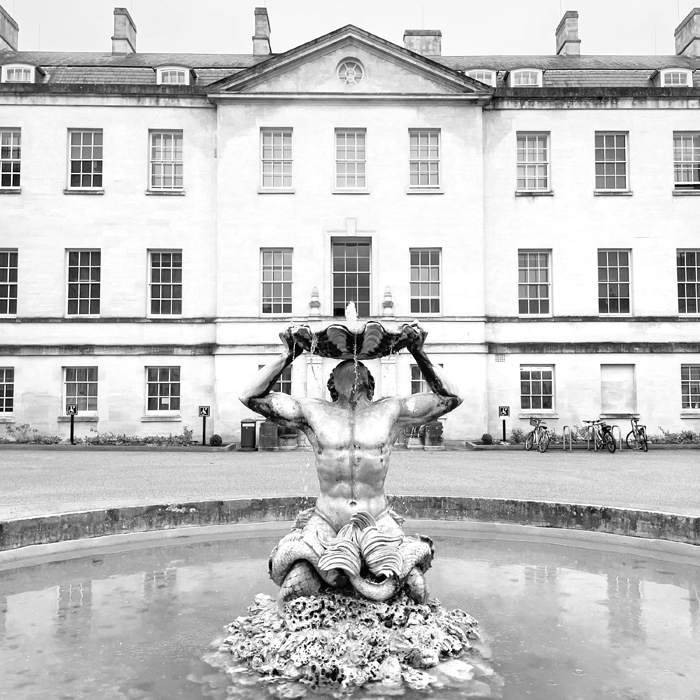
After 150years of serving as a fountain Triton was demounted and taken away to be restored. In fact the figure, now standing in the circular pool on the lawn in front of the newly re-purposed Radcliffe Infirmary, is a complete replacement – and he looks great. Around him the “Observatory Quarter”, a re-developed district of Oxford, is taking shape. But what is particularly bizarre is what has happened to the original figure of Triton that was restored but has ended up in a rather odd location.
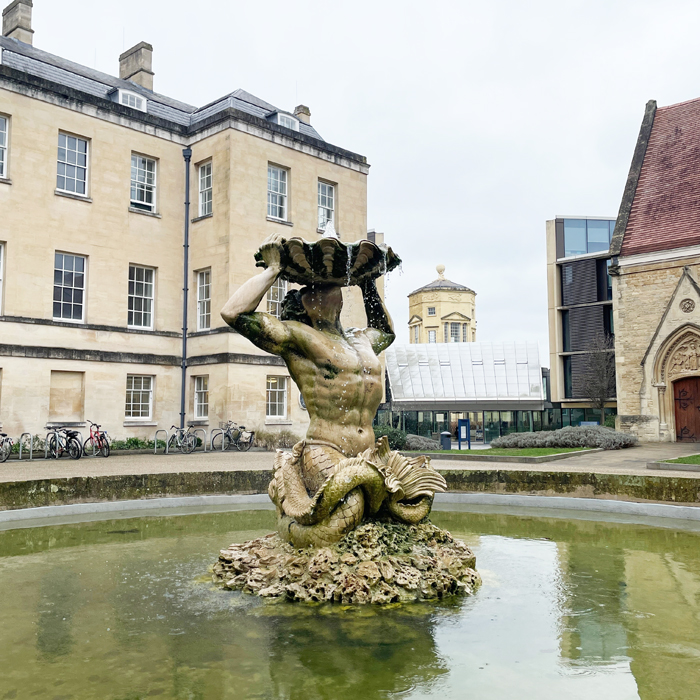
Free Triton!
The dreaming spires of Oxford have, thankfully, long been sacrosanct to the Planning Department of the City of Oxford. In the main the planners have resisted any and all attempts by developers to build upwards and swallow-up the views of the medieval streets, colleges, domes and steeples. One notorious battle to preserve the skyline, a battle lost, now looms over Port Meadow.
Twenty years ago, the University was under enormous pressure to provide more accommodation for graduates – it still is. At Castle Mill, on the wrong side of the railway tracks and bordering the river meadows, they sought and got permission to build a row of accommodation blocks; they went higher than they should. The University and Oxford City Council (together with numerous other stakeholders) were locked into an acrimonious battle for years over what was deemed, for most, a breach of the precious skyline.
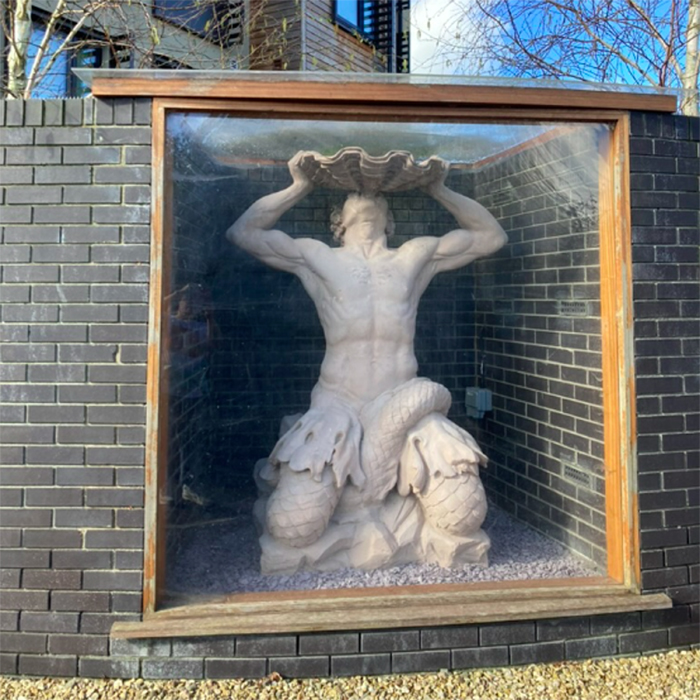
If today you make your way along those Castle Mill tower blocks on foot you will find the pathways follow curved retaining walls and spinneys of new trees. And there you will encounter John Bell’s original Triton figure – now newly restored. He is encased in a perspex box in one of those walls. He looks like a drowning escapologist; it is a thoroughly miserable and inappropriate display. We join “The Oxford Sausage”, (a terrific blogger on all things Oxford – read their post here), in raising the call to “FREE TRITON!”. Hopefully, one day soon, he can be extracted from the confines of his awful tank and be placed on a pedestal in a public space in order he can be properly appreciated by all.
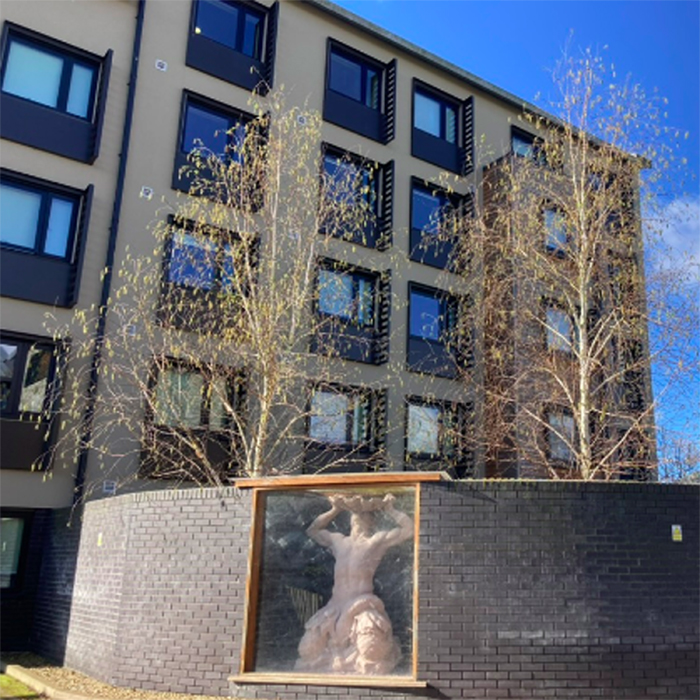
In the meantime we will endeavour to find Erin, his older sister, an altogether happier home to go to.
Anthony Reeve
February 2025
Erin is found in our inventory here.
A pair of urns by Blashfield are also available here.
A stoneware keystone, much earlier, and by Coade can be found here.
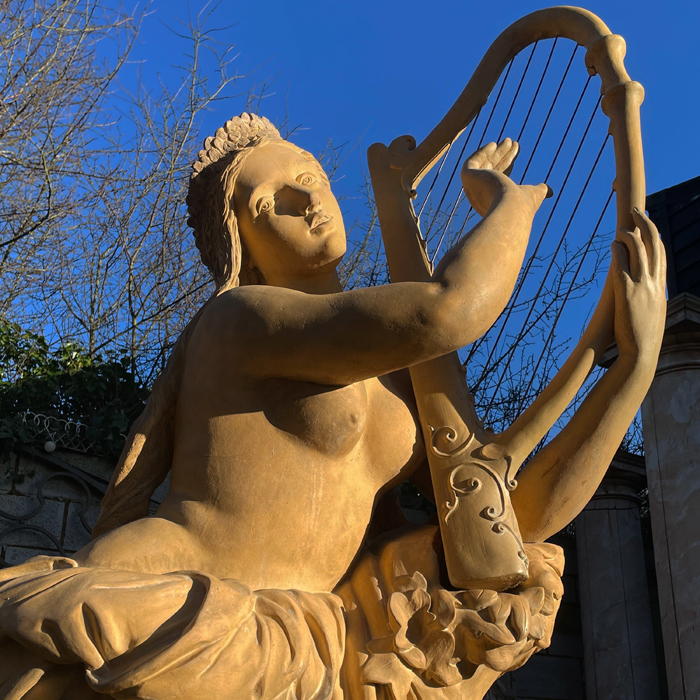
Thanks to: Blane & McGrath for the Dublin photo of Moore and The Oxford Sausage for permission to use theirs of Triton in his prison. 🐜
